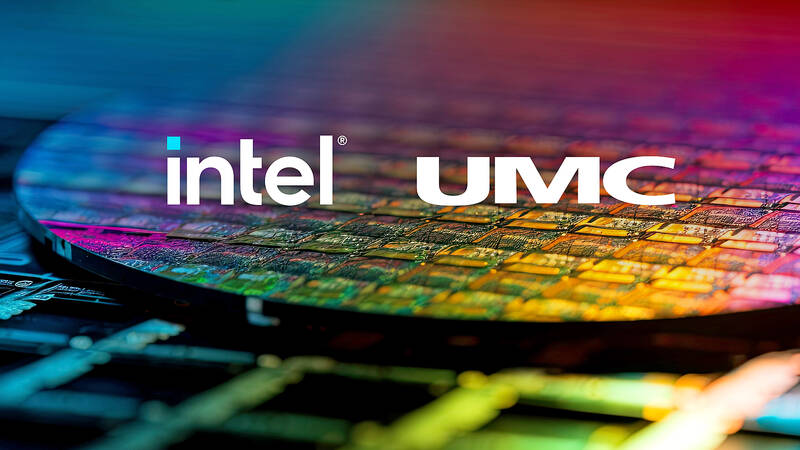United Microelectronics Corp (UMC, 聯電) saw its shares tumble 4.78 percent despite its newly announced collaboration with Intel Corp on 12-nanometer technology, helping the Taiwanese chipmaker secure much-needed advanced chip capacity in the US.
The stock price of UMC closed at NT$49.8 in Taipei, versus the TAIEX’s loss of 0.04 percent and bigger rival Taiwan Semiconductor Manufacturing Co’s (台積電) gain of 0.31 percent yesterday.
UMC has stopped migrating into next-generation technology since 2017, given heavy capital expenditure pressure. Since then, the Hsinchu-based chipmaker has been focusing on offering less-advanced 22-nanometer and 28-nanometer chips.

Photo courtesy of Intel Corp and UMC Corp
However, it is facing rapidly growing competition from capital-rich Chinese peers.
The partnership with Intel would allow UMC to regain its strength in pushing forward its technology capabilities. On Thursday night, UMC said it would team up with Intel to develop 12-nanometer technology to address high-growth markets such as mobile, communication infrastructure and networking.
The long-term agreement brings together Intel’s at-scale US manufacturing capacity and UMC’s extensive foundry experience on mature nodes to enable an expanded process portfolio, the statement said.
It also offers global customers greater choice in their sourcing decisions with access to a more geographically diversified and resilient supply chain, it said.
“Our collaboration with Intel on a US-manufactured 12-nanometer process with FinFET capabilities is a step forward in advancing our strategy of pursuing cost-efficient capacity expansion and technology node advancement in continuing our commitment to customers. This effort will enable our customers to smoothly migrate to this critical new node, and also benefit from the resiliency of an added Western footprint,” UMC co-president Jason Wang (王石) said in the statement.
For Intel, the strategic collaboration with UMC “further demonstrates our commitment to delivering technology and manufacturing innovation across the global semiconductor supply chain and is another important step toward our goal of becoming the world’s second-largest foundry by 2030,” said Stuart Pann, Intel senior vice president and general manager of Intel Foundry Services (IFS).
The 12-nanometer technology node would utilize Intel’s US-based high-volume manufacturing capacity and experience in FinFET transistor design, the statement said. The production would markedly benefit from UMC’s decades of process leadership and history of providing customers with Process Design Kit (PDK) and design assistance for effectively providing foundry services.
The new process node would be developed and manufactured in Fabs 12, 22 and 32 at Intel’s Ocotillo Technology Fabrication site in Arizona. Production of the 12-nanometer process is expected to begin in 2027.
TrendForce Corp (集邦科技), a Taipei-based market researcher, yesterday said the partnership would create a win-win situation as UMC would be able to leverage Intel’s existing factory facilities.
With the collaboration, Intel would take one step further to
expand its foundry services as UMC would play a key role in assisting Intel in negotiating new foundry businesses, in addition to UMC’s 12-nanometer intellectual patents, the researcher said in a report.
“For UMC, this collaboration is a game-changer, allowing it to agilely leverage FinFET capacity without the pressure of heavy capital investments. This move positions UMC to carve out a unique niche in the fiercely competitive mature process market,” TrendForce said.
If this partnership progresses well, Intel might consider expanding their partnerships to one to two more fabs with 1X-nanometer FinFet capacities, likely in Ireland’s Fab 24 and Oregon’s D1B/D1C, TrendForce said.

CHIP RACE: Three years of overbroad export controls drove foreign competitors to pursue their own AI chips, and ‘cost US taxpayers billions of dollars,’ Nvidia said China has figured out the US strategy for allowing it to buy Nvidia Corp’s H200s and is rejecting the artificial intelligence (AI) chip in favor of domestically developed semiconductors, White House AI adviser David Sacks said, citing news reports. US President Donald Trump on Monday said that he would allow shipments of Nvidia’s H200 chips to China, part of an administration effort backed by Sacks to challenge Chinese tech champions such as Huawei Technologies Co (華為) by bringing US competition to their home market. On Friday, Sacks signaled that he was uncertain about whether that approach would work. “They’re rejecting our chips,” Sacks

NATIONAL SECURITY: Intel’s testing of ACM tools despite US government control ‘highlights egregious gaps in US technology protection policies,’ a former official said Chipmaker Intel Corp has tested chipmaking tools this year from a toolmaker with deep roots in China and two overseas units that were targeted by US sanctions, according to two sources with direct knowledge of the matter. Intel, which fended off calls for its CEO’s resignation from US President Donald Trump in August over his alleged ties to China, got the tools from ACM Research Inc, a Fremont, California-based producer of chipmaking equipment. Two of ACM’s units, based in Shanghai and South Korea, were among a number of firms barred last year from receiving US technology over claims they have

It is challenging to build infrastructure in much of Europe. Constrained budgets and polarized politics tend to undermine long-term projects, forcing officials to react to emergencies rather than plan for the future. Not in Austria. Today, the country is to officially open its Koralmbahn tunnel, the 5.9 billion euro (US$6.9 billion) centerpiece of a groundbreaking new railway that will eventually run from Poland’s Baltic coast to the Adriatic Sea, transforming travel within Austria and positioning the Alpine nation at the forefront of logistics in Europe. “It is Austria’s biggest socio-economic experiment in over a century,” said Eric Kirschner, an economist at Graz-based Joanneum

OPTION: Uber said it could provide higher pay for batch trips, if incentives for batching is not removed entirely, as the latter would force it to pass on the costs to consumers Uber Technologies Inc yesterday warned that proposed restrictions on batching orders and minimum wages could prompt a NT$20 delivery fee increase in Taiwan, as lower efficiency would drive up costs. Uber CEO Dara Khosrowshahi made the remarks yesterday during his visit to Taiwan. He is on a multileg trip to the region, which includes stops in South Korea and Japan. His visit coincided the release last month of the Ministry of Labor’s draft bill on the delivery sector, which aims to safeguard delivery workers’ rights and improve their welfare. The ministry set the minimum pay for local food delivery drivers at